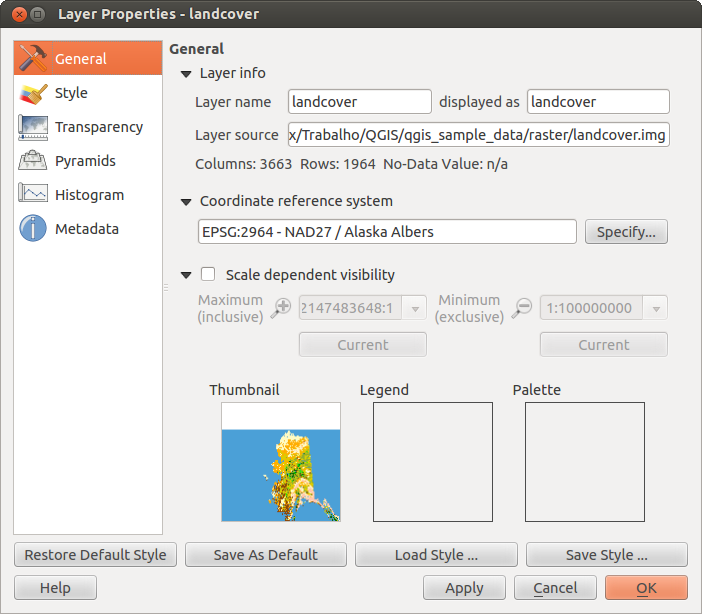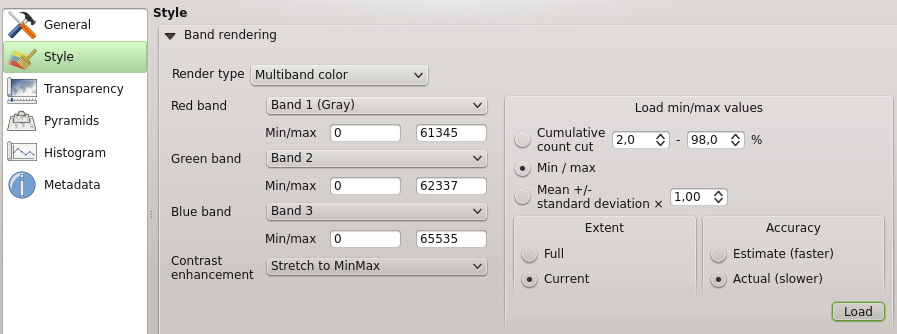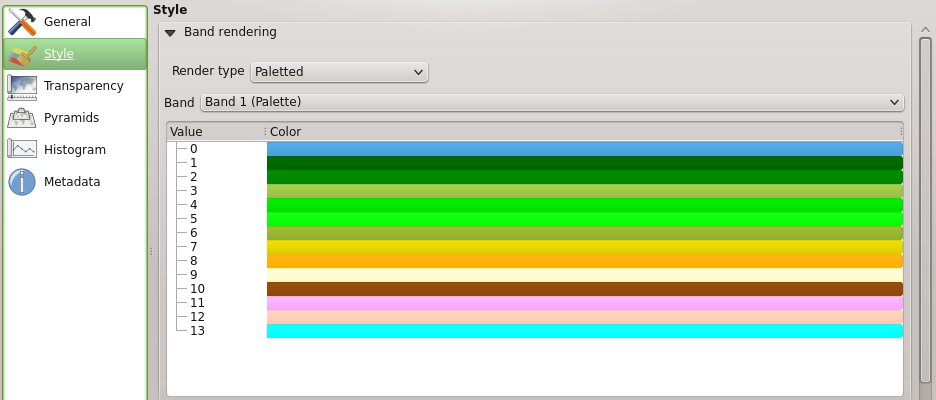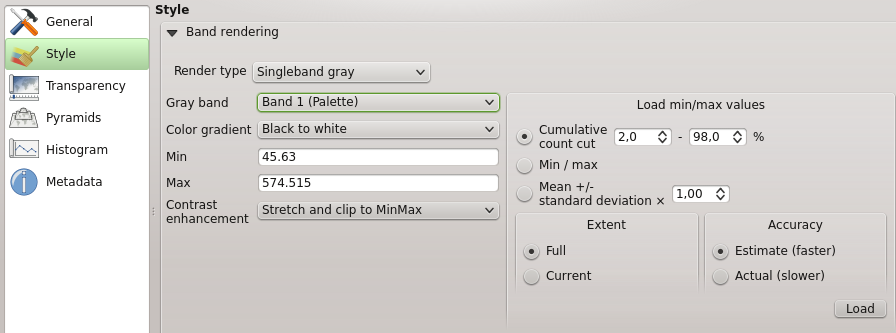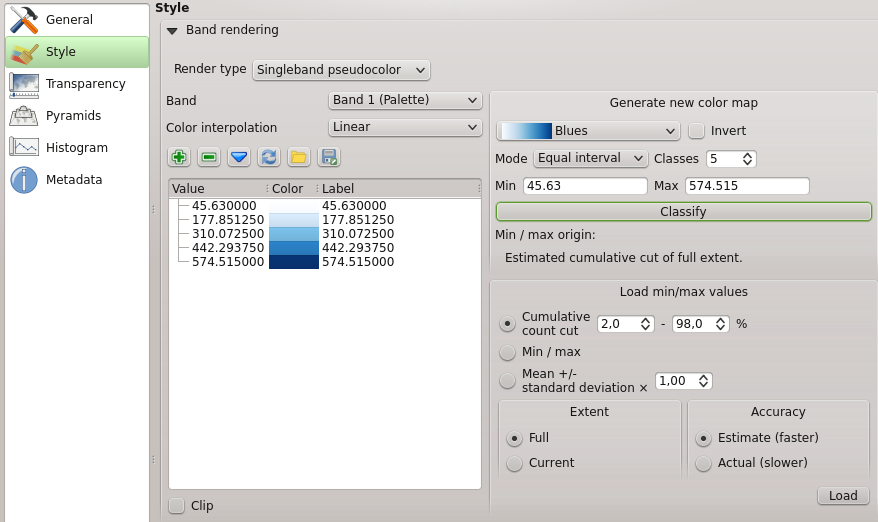Inhoudsopgave
- User guide/Manual (QGIS 2.0)
- Inleiding
- Conventies
- Voorwoord
- Functionaliteit
- Wat is er nieuw in QGIS 2.0
- Beginnen
- QGIS GUI
- Algemeen Gereedschap
- QGIS Configureren
- Werken met Projecties
- QGIS Browser
- Werken met Vector Data
- Werken met Raster data
- Werken met OGC Data
- Werken met GPS Data
- GRASS GIS Integration
- QGIS processing framework
- Print Composer
- Plugins
- Ondersteuning
- Appendix
- Literature and Web References
- User guide/Manual PDF’s
- PyQGIS cookbook (QGIS 2.0)
- Documentation Guidelines
- A gentle introduction in GIS
- Trainings manual
Raster Eigenschappen Dialoog¶
Om de eigenschappen van een rasterlaag te bekijken en in te stellen, dubbelklik op de naam van een rasterlaag in de legenda of selecteer de laag en gebruik de rechtermuisknop en kies Eigenschappen van het snelmenu:
Dit zal de dialoog Raster Laag Eigenschappen openen (zie figure_raster_1).
De dialoog bevat verschillende tabbladen:
Algemeen
Stijl
Transparantie
Pyramiden
- Histogram
- Metadata
Figure Raster 1:
Tabblad Algemeen¶
Laag Info¶
The General menu displays basic information about the selected raster, including the layer source path, the display name in the legend (which can be modified) and the number of columns, rows and No-Data Values of the raster.
Coördinaten referentie systeem¶
Ook het Coordinaten Referentie Systeem (CRS) wordt hier weergegeven als een PROJ.4-tekst. Deze kan worden aangepast via de knop [Opgeven...].
Schaalafhankelijke zichtbaarheid¶
Daarnaast kunnen schaalafhankelijke zichtbaarheden worden ingesteld in dit tabblad. Vink daarvoor het aanvinkvak schaalafhankelijke zichtbaarheid aan en stel het bereik van de schalen waarvoor de data getoond moet worden op de kaart.
Onderin kun je een ‘thumbnail’, een kleine afbeelding van de laag zien, het gebruikte legenda symbool en het kleurenpalet.
Tabblad Stijl¶
Enkelbands Renderen¶
QGIS offers four different Render types. The renderer chosen is dependent on the data type.
- Multiband color - if the file comes as a multi band with several bands (e.g. used with a satellite image with several bands)
- Paletted - if a single band file comes with an indexed palette (e.g. used with a digital topographic map)
- Singleband gray- (one band of) the image will be rendered as gray, QGIS will choose this renderer if the file neither has multi bands, nor has an indexed palette nor has a continous palette (e.g. used with a shaded relief map)
- Singleband pseudocolor - this renderer is possible for files with a continuous palette, e.g. the file has got a color map (e.g. used with an elevation map)
Multibands kleur
Met de multibands kleur renderer zullen drie banden van het image worden gebruikt om te renderen, waarbij elke band staat voor de rode, groene of blauwe component die worden gebruikt om een kleurenafbeelding op te bouwen. Je kunt kiezen tussen verschillende Contrast verbeterings methoden: ‘Geen verbetering’, ‘Stretch to MinMax’, ‘Stretch and clip to MinMax’ en ‘Clip to min max’.
Figure Raster 2:
This selection offers you a wide range of options to modify the appearance
of your rasterlayer. First of all you have to get the data range from your
image. This can be done by choosing the Extent and pressing
[Load]. QGIS can  Estimate (faster) the
Min and Max values of the bands or use the
Estimate (faster) the
Min and Max values of the bands or use the
 Actual (slower) Accuracy.
Actual (slower) Accuracy.
Now you can scale the colors with the help of the Load min/max values section.
A lot of images have few very low and high data. These outliers can be eliminated
using the  Cumulative count cut setting. The standard data range is set
from 2% until 98% of the data values and can be adapted manually. With this
setting the gray character of the image can disappear.
With the scaling option
Cumulative count cut setting. The standard data range is set
from 2% until 98% of the data values and can be adapted manually. With this
setting the gray character of the image can disappear.
With the scaling option  Min/max QGIS creates a color table with
the whole data included in the original image. E.g. QGIS creates a color table
with 256 values, given the fact that you have 8bit bands.
You can also calculate your color table using the
Min/max QGIS creates a color table with
the whole data included in the original image. E.g. QGIS creates a color table
with 256 values, given the fact that you have 8bit bands.
You can also calculate your color table using the  Mean +/- standard deviation x
Mean +/- standard deviation x  .
Then only the values within the standard deviation or within multiple standard deviations
are considered for the color table. This is useful when you have one or two cells
with abnormally high values in a raster grid that are having a negative impact on
the rendering of the raster.
.
Then only the values within the standard deviation or within multiple standard deviations
are considered for the color table. This is useful when you have one or two cells
with abnormally high values in a raster grid that are having a negative impact on
the rendering of the raster.
Alle berekeningen kunnen ook worden gedaan voor de  Huidige extent.
Huidige extent.
Tip
Het tonen van een enkelbands of meerbands Raster
Wanneer je een enkele band raster wilt tonen (bijvoorbeeld de Rode) van een multibands afbeelding, zou je denken dat je de Groene en Blauwe band uitschakeld. Maar dit is niet de goede manier. Om de Rode band te tonen, zet het imagetype naar grijstinten en selecteer Rood als de te gebruiken band voor Grijstinten.
Paletted
This is the standard render option for singleband files that already include a color table, where each pixel value is assigned to a certain color. In that case, the palette is rendered automatically. If you want to change colors assigned to certain values, just double-click on the color and the Select color dialog appears.
Figure Raster 3:
Contrastverhoging
Notitie
Wanneer een GRASS raster wordt toegevoegd, zal de optie Contrastverbetering altijd op automatisch gezet worden op stretch to min max ook al is er gekozen onder QGIS algemene instellingen gekozen voor een andere waarde.
Enkelbands grijs
This renderer allows you to render a single band layer with a Color gradient
‘Black to white’ or ‘White to black’. You can define a Min
and a Max value with choosing the Extend first and
then pressing [Load]. QGIS can  Estimate (faster) the
Min and Max values of the bands or use the
Estimate (faster) the
Min and Max values of the bands or use the
 Actual (slower) Accuracy.
Actual (slower) Accuracy.
Figure Raster 4:
With the Load min/max values section scaling of the color table
is possible. Outliers can be eliminated using the  Cumulative count cut setting.
The standard data range is set from 2% until 98% of the data values and can
be adapted manually. With this setting the gray character of the image can disappear.
Further settings can be made with
Cumulative count cut setting.
The standard data range is set from 2% until 98% of the data values and can
be adapted manually. With this setting the gray character of the image can disappear.
Further settings can be made with  Min/max and
Min/max and
 Mean +/- standard deviation x
Mean +/- standard deviation x  .
While the first one creates a color table with the whole data included in the
original image the second creates a colortable that only considers values
within the standard deviation or within multiple standard deviations.
This is useful when you have one or two cells with abnormally high values in
a raster grid that are having a negative impact on the rendering of the raster.
.
While the first one creates a color table with the whole data included in the
original image the second creates a colortable that only considers values
within the standard deviation or within multiple standard deviations.
This is useful when you have one or two cells with abnormally high values in
a raster grid that are having a negative impact on the rendering of the raster.
Enkelbands pseudokleur
This is a render option for single band files including a continous palette. You can also create individual color maps for the single bands here.
Figure Raster 5:
Er zijn drie manieren van kleurinterpolatie beschikbaar:
Discreet
Lineair
- Exact
In de linkerblok voegt de knop  Handmatig waarden toevoegen een waarde toe aan een kleurentabel. De knop
Handmatig waarden toevoegen een waarde toe aan een kleurentabel. De knop  Geselecteerde regel verwijderen verwijderd een waarde van een kleurentabel en de knop
Geselecteerde regel verwijderen verwijderd een waarde van een kleurentabel en de knop  Sorteer onderdelen kleurenkaart sorteert de kleurentabel op basis van de pixelwaarde gegeven in de kolom
Sorteer onderdelen kleurenkaart sorteert de kleurentabel op basis van de pixelwaarde gegeven in de kolom Waarde. Door te dubbelklikken op de kolom Waarde kun je ook een specifieke waarde toevoegen. Door te dubbelklikken op de kolom Kleur opent de dialoog Select Color waarin je een kleur kunt kiezen die van toepassing is op gegeven waarde.. Daarnaast kun je ook elke kleur een Label geven maar deze waarde zal niet getoond worden wanneer de tool Objecten Identificeren wordt gebruikt. Je kunt de knop  Laad kleurenkaart van band gebruiken waarmee de kleurentabel van de band probeert de laden (indien aanwezig). Je kunt ook de knoppen
Laad kleurenkaart van band gebruiken waarmee de kleurentabel van de band probeert de laden (indien aanwezig). Je kunt ook de knoppen  Laden kleurenkaart van bestand of
Laden kleurenkaart van bestand of  Exporteer kleurenkaart naar bestand gebruiken om een bestaande kleurentabel te laden of om deze te bewaren voor een andere sessies.
Exporteer kleurenkaart naar bestand gebruiken om een bestaande kleurentabel te laden of om deze te bewaren voor een andere sessies.
In the right block Generate new color map allows you to create newly
categorized colormaps. For the Classification mode  ‘Equal interval’
you only need to select the number of classes
‘Equal interval’
you only need to select the number of classes
 and press the button Classify. You can invert the colors
of the the color map by clicking the
and press the button Classify. You can invert the colors
of the the color map by clicking the  Invert
checkbox. In case of the Mode
Invert
checkbox. In case of the Mode  ‘Continous’ QGIS creates
classes depending on the Min and Max automatically.
Defining Min/Max values can be done with the help of Load min/max values section.
A lot of images have few very low and high data. These outliers can be eliminated
using the
‘Continous’ QGIS creates
classes depending on the Min and Max automatically.
Defining Min/Max values can be done with the help of Load min/max values section.
A lot of images have few very low and high data. These outliers can be eliminated
using the  Cumulative count cut setting. The standard data range is set
from 2% until 98% of the data values and can be adapted manually. With this
setting the gray character of the image can disappear.
With the scaling option
Cumulative count cut setting. The standard data range is set
from 2% until 98% of the data values and can be adapted manually. With this
setting the gray character of the image can disappear.
With the scaling option  Min/max QGIS creates a color table with
the whole data included in the original image. E.g. QGIS creates a color table
with 256 values, given the fact that you have 8bit bands.
You can also calculate your color table using the
Min/max QGIS creates a color table with
the whole data included in the original image. E.g. QGIS creates a color table
with 256 values, given the fact that you have 8bit bands.
You can also calculate your color table using the  Mean +/- standard deviation x
Mean +/- standard deviation x  .
Then only the values within the standard deviation or within multiple standard deviations
are considered for the color table.
.
Then only the values within the standard deviation or within multiple standard deviations
are considered for the color table.
Het renderen van kleuren¶
For every Band rendering a Color rendering is possible.
You can achieve special rendering effects for your raster file(s) using one one of the blending modes (see blend_modes).
Further settings can be made in modifiying the Brightness, the Saturation and the Contrast. You can use a Grayscale option where you can choose between ‘By lightness’, ‘By luminosity’ and ‘By average’. For one hue in the color table you can modiy the ‘Strength’.
Resampling¶
The Resampling option makes it appearance when you zoom in and out of the image. Resampling modes can optimize the appearance of the map. They calculate a new gray value matrix through a geometric transformation.
While applying the ‘Nearest neighbour’ method the map can have a pixelated structure when zooming in. This appearance can be improved by using the ‘Bilinear’ or ‘Cubic’ method. Sharp features are caused to be blurred now. The effect is a smoother image. The method can be applied e.g. to digital topographic raster maps.
Tabblad Transparantie¶
QGIS heeft de mogelijkheid om elke rasterlaag to tonen met verschillende transparantie percentages. Gebruik de transparantie schuifschaal om aan te geven in welke mate de onderliggende lagen zichtbaar worden onder de huidige rasterlaag. Dit komt goed van pas om verschillende rasterlagen over elkaar heen te leggen, bijvoorbeeld een schaduwrijke reliëfkaart met een geklassificeerde rasterkaart. Dat zal er voor zorgen dat de kaart er meer driedimensionaal uitziet.
Daarnaast kun je aangeven welke rasterwaarde als geen data behandeld moet worden in het menu Extra geen data waarde.
En nog flexibelere manier om de transparantie te regelen kan gedaan worden via Aangepaste transparantie opties. De transparantie voor elke pixelwaarde kan hier worden ingesteld.
Als voorbeeld willen we de transparantie van het water van het voorbeeld rasterbestand landcover.tif instellen op 20%. Daarvoor zijn de volgende stappen nodig:
Laad het rasterbestand
landcover.Open de dialoog Eigenschappen door te dubbelklikken op de rasterlaag in de legenda of via het snelmenu die via de rechtermuisknop in de legenda geopend wordt voor geselecteerde rasterlaag en te kiezen voor Eigenschappen.
Selecteer het tabblad Transparantie
In het menu guilabel:Transparantie band kies ‘Geen’.
Klik op
 Voeg handmatig waarden toe. Een nieuwe regel zal worden toegevoegd aan de Transparantie pixellijst.
Voeg handmatig waarden toe. Een nieuwe regel zal worden toegevoegd aan de Transparantie pixellijst.Geef de raster waarde (we gebruiken hier 0) in de kolom ‘Van’ en ‘Tot’ en pas daarvan de transparatie aan naar 20 %.
Druk op de knop [Apply] en controleer het resultaat van de kaart.
Stappen 4 en 5 kunnen herhaald worden om meer waarden te wijzigen met een aangepaste transparantie.
Het is eenvoudig om een aangepaste transparantie op te zetten, maar dit is aardig wat werk. De knop  Naar bestand exporteren geeft dan ook de mogelijkheid om de Transparantie pixellijst op te slaan naar bestand. Met de knop
Naar bestand exporteren geeft dan ook de mogelijkheid om de Transparantie pixellijst op te slaan naar bestand. Met de knop  van bestand importeren kun de transparantie lijst weer laden en wordt deze toegepast op de huidige rasterlaag.
van bestand importeren kun de transparantie lijst weer laden en wordt deze toegepast op de huidige rasterlaag.
Tabblad Pyramiden¶
Rasterlagen met een hoge resolutie, kunnen het navigeren binnen QGIS langzaam maken. Door het aanmaken van lagere resolutie kopiëen (pyramiden), kan de performance van QGIS aanzienlijk worden verbeterd aangezien QGIS de kopie met de meest geschikte resolutie selecteerd voor elk zoom niveau.
Je moet schrijfrechten hebben op de folder waarin de originel rasterdata is opgeslagen om pyramiden te bouwen.
Verschilldende resampling methoden kunnen worden gebruikt om pyramiden te berekenen:
- Nearest Neighbour
Gemiddelde
- Gauss
- Cubic
Modus
Geen
If you choose ‘Internal (if possible)’ from the Overview format menu QGIS tries to build pyramids internally. You can also choose ‘External’ and ‘External (Erdas Imagine)’.
Merk op dat het bouwen van pyramiden de originele databestanden kan veranderen en dat interne aangemaakt pyramiden niet meer verwijderd kunnen worden. Het is dan ook altijd verstandig om van het origineel (zonder pyramiden) eerst een kopie te maken en te bewaren.
Tabblad Histogram¶
The Histogram menu allows you to view the distribution of the bands
or colors in your raster. It is generated automatically when you open the
Histogram menu. All existing bands will be displayed together. You can
save the histogram as an image with the  button.
With the Visibility option in the
button.
With the Visibility option in the  Prefs/Actions menu
you can display histograms of the individual bands. You will need to select the option
Prefs/Actions menu
you can display histograms of the individual bands. You will need to select the option
 Show selected band.
The Min/max options allow you to ‘Always show min/max markers’, to ‘Zoom
to min/max’ and to ‘Update style to min/max’.
With the Actions option you can ‘Reset’ and ‘Recompute histogram’ after
you have chosen the Min/max options.
Show selected band.
The Min/max options allow you to ‘Always show min/max markers’, to ‘Zoom
to min/max’ and to ‘Update style to min/max’.
With the Actions option you can ‘Reset’ and ‘Recompute histogram’ after
you have chosen the Min/max options.
Tabblad Metadata¶
Het tabblad Metadata toont veel informatie over de rasterlaag, inclusief statistieken over elke band in de huidige rasterlaag. In dit tabblad zijn de onderdelen Beschrijving, Attributen, MetadataUrl en Eigenschappen aanwezig. In Eigenschappen worden statistieken verzameld wanneer nodig, het is dus best mogelijk dat voor een gegeven laag de statistieken nog niet zijn verzameld of inmiddels verouderd zijn.
